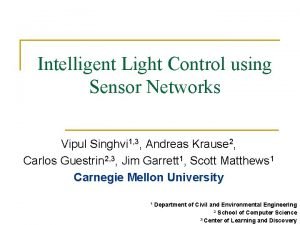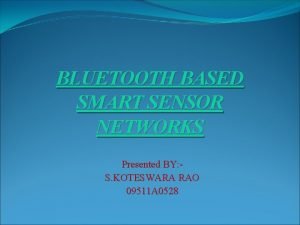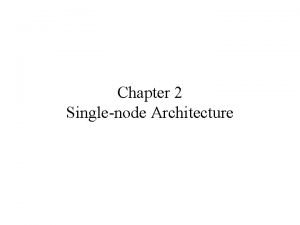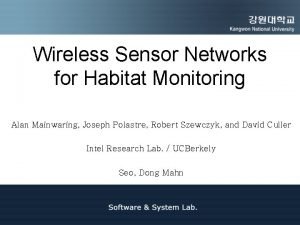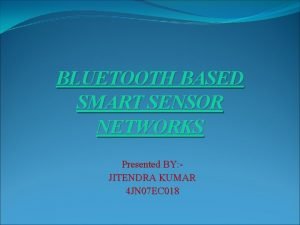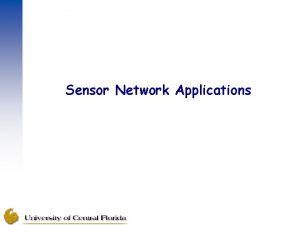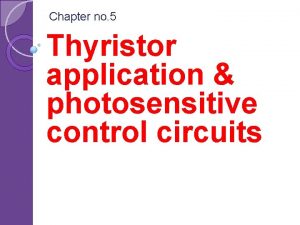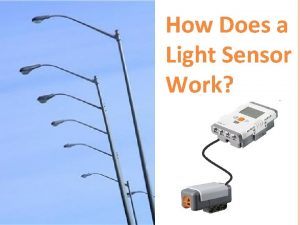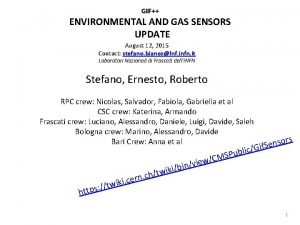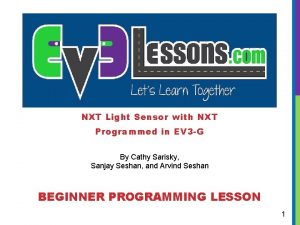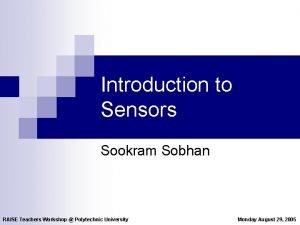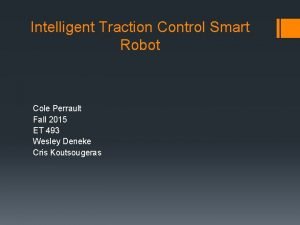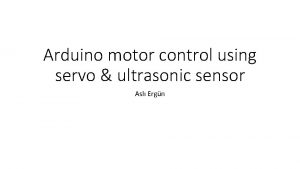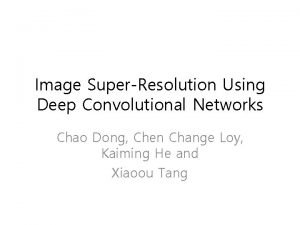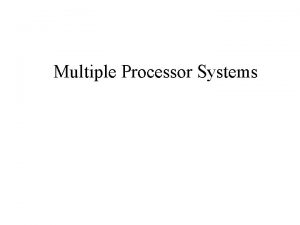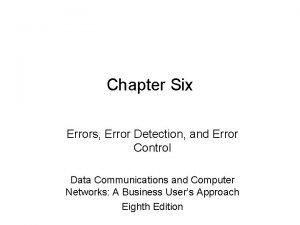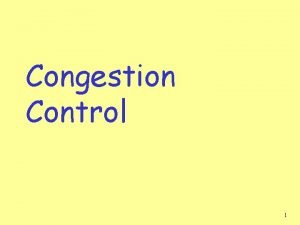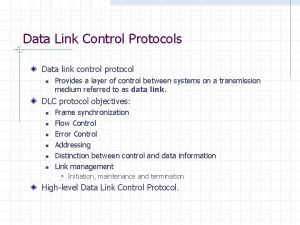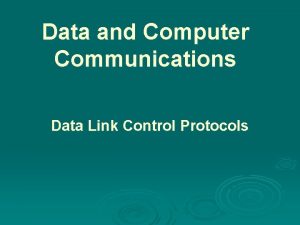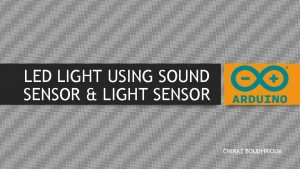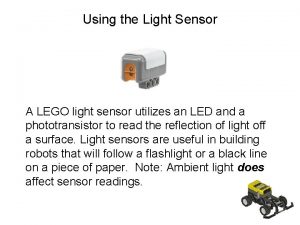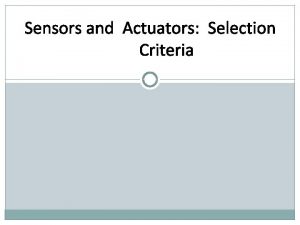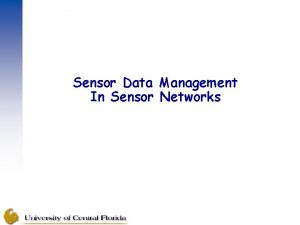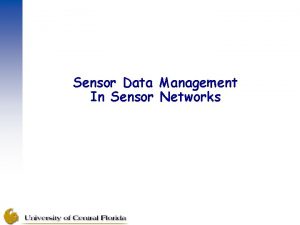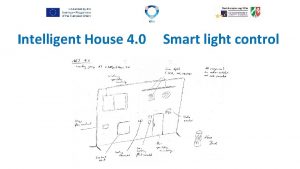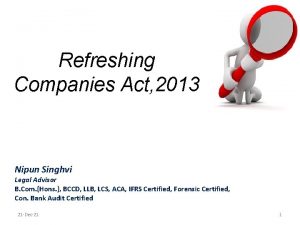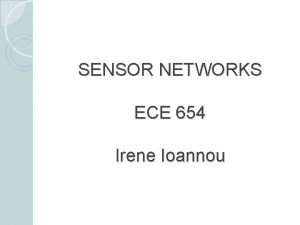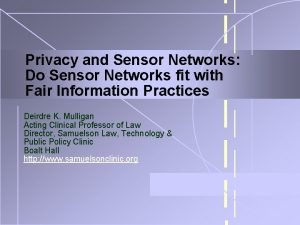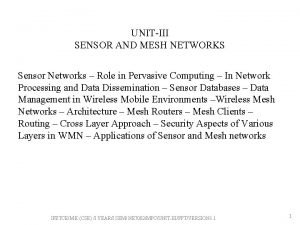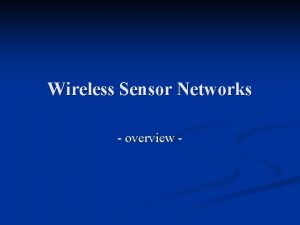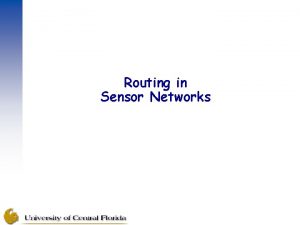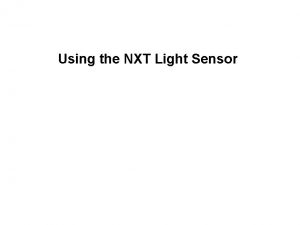Intelligent Light Control using Sensor Networks Vipul Singhvi
































- Slides: 32

Intelligent Light Control using Sensor Networks Vipul Singhvi 1, 3, Andreas Krause 2, Carlos Guestrin 2, 3, Jim Garrett 1, Scott Matthews 1 Carnegie Mellon University 1 Department of Civil and Environmental Engineering 2 School of Computer Science 3 Center of Learning and Discovery

Motivation n n Current built infrastructure q Trillions of dollars investment Cost over the life cycle Research shows potential gains from reducing operating cost and Life cycle building cost Sensor networks improving occupant performance Maintenance and monitoring and actuationoperation q $10 Smart - $30 billion/yr from reduced Construction energy canconsumption significantly reduce cost and $20 - $160 billion/yr gained from improve occupant performance improvement in comfort leading to better occupant performance Reduction in energy cost related Salary cost over building life cycle to reduced comfort & performance: Complex tradeoff optimization

Motivating Scenario Operator All lights 0 -10 levels 0 10 Coordinate lighting to make everybody happy Louvers Controller Andy Bob Strategy to exploit natural lighting 50 5 0 Louvers/ Blinds 0 5 Predictive light control 0 10 06 Feed back

Challenges n Knowing the current state q Light levels and occupants location Capturing occupant and operator preferences & happiness n Optimization of tradeoff n q Occupants happier OR save more energy

Knowing the current state of the world n Indoor Environment q n Light levels Tracking occupants q Pervasive sensor network q n Wireless or Wired Desk q q Smart tags RFID tags Camera tracking

Preferences & Happiness n n Utility Theory: Framework to compare choices based on preferences Personal preference Attributes: Coolness, Horse Power, Mileage, COST…. Representation complexity of utility function Lamborghini, Second Hand 2003 model, $50, 000 Toyota Corolla, New 2006 model, $30, 000

Building Operations: Occupants n Occupant preference: Comfort q n Utility Function Task dependent Light levels q Depends on lamp setting q Use sensing to learn effect of lamps on person i – q Control lamp settings a to max. occupant preferences, a=(a 1, …, an), aj – level of lamp j q n Light level Bob Andy

Building Operations: Operator q q n Cheaper the better Operator preference: Cost Operating cost Maintenance Cost Decreases monotonically with the energy expended Normalized utility n 1. 00 0. 80 0. 60 0. 40 0. 20 0. 00 100 200 Operating Cost n Utility function q aj , jth lamp 300

Utility Maximization : Tradeoff n Maximize system utility: Make occupants and operator Occupants happy! q n a = (a 1, ……. an) Scalarization technique q is the tradeoff parameter

Utility Maximization: Complexity 10 levels a 2 10 levels a 1 n n a 4 10 levels a 6 a 5 10 levels Evaluating U(a) for combinations of all lamp setting q n 10 levels for just 6 lamps the total number is 106 Evaluating argmax U(a) is also over that big space Exponential in number of lamps!

Reducing Complexity n Exploit problem structure: Zoning a 2 a 1 n a 4 a 6 a 5 Distributed action selection approach (Guestrin ’ 03) q Exact solution to the coordination problem

Open-loop controller: Coordinated Lighting Control law using Occupant utility and Coordination Graph approach a

Test Bed n n Control Schematics 10 table lamps 12 motes aka occupants Size: 146 * 30 in. , 7 zones 146 in. 7 6 5 4 3 2 1

Coordinated Lighting: Results 30% Coordinated Illumination Energy Cost Greedy Heuristic Measured utility 0. 4 • Comparison to greedy approach • Each occupant comes and actuates the light • Caveat: cannot reduce the level of a already ON light • At = 0. 4, reduction in comfort = 7% but reduction in energy cost = 30%

Coordinated Lighting n n Performs significantly better than typical greedy approach Solves the complex optimization using the structure of the problem (zoning) Predictive light control Natural Lighting Coordinated Lighting

Closed-loop controller: Daylight n Sense natural light levels Harvesting n Actuate lamps to compensate for extra light Control law Online sensing using sensor network Current Light Level a

Day Light Harvesting: Sun Lamps Simulation n Simulated sun using overhead lamps n Real sun intensities Variability using the real sunlight data from Pittsburgh Measured intensities at center

Daylight Harvesting: Utility Redefined n Represents the sunlight intensity at time t and point in space x, n New utility definition n Maximization problem Sun Lamps

Running the Simulations

Day Light Harvesting: Evaluation n Gamma values (0. 01, 0. 4), same setup Energy Cost Measured Utility n n n Energy Cost Gamma = 0. 01, 15% of energy savings Gamma = 0. 4, 55% of energy savings Loss in occupant utility due to too much light q Shading, Louvers

Day light harvesting n n Builds on the coordinated lighting approach Saves significant (~50%)energy cost during sun time Long term sensor Predictive deployment: battery life light control Sensor scheduling q Save battery life Natural Lighting Coordinated Lighting

Active Sensing aka Sensor n. Scheduling Spatial correlation in sunlight distribution n Temporal correlation in sunlight intensity Use only a small number of sensor Estimate the light levels at other times and When and Where to sense! locations ? Desk ? ? ?

Active Sensing: Scheduling n Use sunlight observation (samples) to estimate the current sunlight intensity distribution n The utility formulation then changes to conditional expected utility Sunlight Distribution Conditioned on observation n Choose a set of observations that yields best maximum expected utility values

Active Sensing n Calculating a set of observation that maximize n More observation: better accuracy but high battery cost Constraint the observations to a budget n q Allocate strategically to max. EU

Active Sensing: Single Sensor n Optimal solution for single sensor budget allocation in polynomial time (Krause & Guestrin ’ 05) X 1 n n X 2 X 3 X 4 X 5 Xi where i is the time step, (5 times steps, Budget 2) For just 2 sensors: complexity is NP-hard XX 1 XX 2 XX 3 XX 4 XX 5 1 2 3 4 5 Y 1 Y 2 Y 3 Y 4 Y 5

Active Sensing: Heuristic n n n Heuristic for solving multiple sensor q Coordinate ascent scheme (uses optimal solution for single sensor) X 1 Optimize sensor 1 X 2 X 3 X 4 X 5 Y 1 Y 2 Y 5 Y 3 Y 4 Optimize sensor 2 Guaranteed to improve score on each iteration, guaranteed to not perform worse than independent scheduling Can be used for more than 2 sensors

Active Sensing: Results No sensing Energy Cost 1 obs. /sensor n n n 10 obs. /sensor Measured Utility 3 sensors, upto 10 readings per sensor in a day Energy saving are close approximation compared to sensing continuously Even a small number of readings (3) provides results as good as continuous

Active Sensing for Daylight Harvesting n Exploit temporal correlation in sunlight n n intensity to schedule sensing Significant reduction in sensing requirement for comparable performance Can be integrated in the coordinated lighting formulation Predictive light control Natural Lighting Coordinated Lighting

Predictive light control n Probabilistic model on mobility q n People move independent of each other Modeled using a random walk q q Stay in same position Move left, move right Zone 2 Zone 1

Integrating mobility n Assuming full observability n Computing expected utility Probability of motion

Predictive Lighting: Results Normalized Scale Occupant Utility n n n Using prediction Without prediction Occupant Utility Energy Cost Total Utility Energy Cost 20 step random walk Total utility increase of about 25% Low values of trade-off parameter, system prefers occupants comforts

Conclusion Coordinated lighting strategy • Maximizes happiness using utility maximization • Solves complex coordination problem Day light harvesting • Exploits natural light sources using sensors • 50 -70% reduction in energy consumption Active sensing • Sensor scheduling using sunlight distribution • Substantial increase in network life time Predictive Light control • Captures occupant mobility • Higher total utility for the system
 Vipul singhvi
Vipul singhvi Bluetooth-based smart sensor networks
Bluetooth-based smart sensor networks Maersk adalah
Maersk adalah G.v.k. rao committee in tamil
G.v.k. rao committee in tamil Light light light chapter 23
Light light light chapter 23 Light light light chapter 22
Light light light chapter 22 Light light light chapter 22
Light light light chapter 22 Single node architecture in wsn
Single node architecture in wsn Wireless sensor networks for habitat monitoring
Wireless sensor networks for habitat monitoring Bluetooth based smart sensor networks
Bluetooth based smart sensor networks Habitat monitoring sensor
Habitat monitoring sensor Phase control triac
Phase control triac Virtual circuit tables
Virtual circuit tables Basestore iptv
Basestore iptv How light sensor works
How light sensor works Mindstorms nxt 2
Mindstorms nxt 2 Ide gas gif
Ide gas gif Light sensor
Light sensor Light sensor diagram
Light sensor diagram Intelligent traction control
Intelligent traction control Disadvantages of foot step power generation
Disadvantages of foot step power generation Arduino ultrasonic sensor
Arduino ultrasonic sensor Audio super resolution using neural networks
Audio super resolution using neural networks Leon gatys
Leon gatys Neural network matlab toolbox
Neural network matlab toolbox Image super resolution using deep convolutional networks
Image super resolution using deep convolutional networks Uma multiprocessors using multistage switching networks
Uma multiprocessors using multistage switching networks Predicting nba games using neural networks
Predicting nba games using neural networks Audio super resolution
Audio super resolution Error control in computer networks
Error control in computer networks General principles of congestion control
General principles of congestion control High level data link control protocol
High level data link control protocol Communication data link
Communication data link
